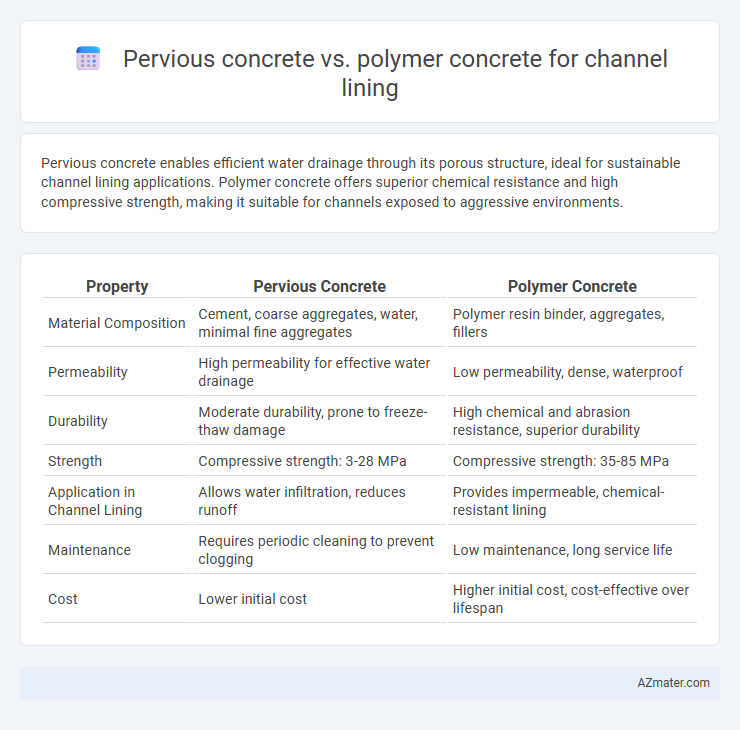Pervious concrete enables efficient water drainage through its porous structure, ideal for sustainable channel lining applications. Polymer concrete offers superior chemical resistance and high compressive strength, making it suitable for channels exposed to aggressive environments.
Table of Comparison
| Property | Pervious Concrete | Polymer Concrete |
|---|---|---|
| Material Composition | Cement, coarse aggregates, water, minimal fine aggregates | Polymer resin binder, aggregates, fillers |
| Permeability | High permeability for effective water drainage | Low permeability, dense, waterproof |
| Durability | Moderate durability, prone to freeze-thaw damage | High chemical and abrasion resistance, superior durability |
| Strength | Compressive strength: 3-28 MPa | Compressive strength: 35-85 MPa |
| Application in Channel Lining | Allows water infiltration, reduces runoff | Provides impermeable, chemical-resistant lining |
| Maintenance | Requires periodic cleaning to prevent clogging | Low maintenance, long service life |
| Cost | Lower initial cost | Higher initial cost, cost-effective over lifespan |
Introduction to Channel Lining Materials
Channel lining materials significantly impact hydraulic efficiency and durability in water conveyance systems. Pervious concrete offers high permeability, reducing surface runoff and promoting groundwater recharge, making it suitable for sustainable drainage channels. Polymer concrete provides superior chemical resistance and mechanical strength, ideal for harsh environments requiring durable, low-maintenance channel linings.
Overview of Pervious Concrete
Pervious concrete is a highly porous material designed to allow water infiltration, making it ideal for channel lining where effective drainage and runoff management are critical. Its void structure facilitates natural groundwater recharge and reduces surface water accumulation, enhancing stormwater control in urban and environmental applications. Compared to polymer concrete, which offers higher chemical resistance and strength, pervious concrete excels in permeability and sustainable water management.
Overview of Polymer Concrete
Polymer concrete is a composite material consisting of a polymer binder and aggregates, known for its high strength, chemical resistance, and rapid curing properties, making it ideal for channel lining applications. Its dense, non-porous structure prevents water infiltration and reduces erosion, enhancing durability under harsh environmental conditions and heavy flow. Compared to pervious concrete, polymer concrete offers superior adhesion, flexibility, and resistance to freeze-thaw cycles, providing longer service life in channel lining projects.
Key Material Properties Comparison
Pervious concrete offers high permeability, allowing efficient stormwater infiltration, making it ideal for sustainable channel lining. Polymer concrete exhibits superior chemical resistance and durability, with enhanced tensile strength and reduced permeability, ensuring long-term structural integrity in aggressive environments. The choice between pervious and polymer concrete depends on the balance between hydraulic performance and resistance to environmental stressors in channel lining applications.
Hydraulic Performance: Permeability and Flow
Pervious concrete offers superior hydraulic performance for channel lining due to its high permeability, allowing efficient water flow and rapid drainage that reduces runoff and erosion risks. Polymer concrete features lower permeability but provides increased chemical resistance and durability, making it suitable for channels exposed to aggressive fluids. The choice depends on prioritizing flow capacity with pervious concrete or enhanced structural integrity and chemical resistance with polymer concrete.
Durability and Chemical Resistance
Pervious concrete offers excellent drainage and moderate durability but is susceptible to chemical degradation when exposed to aggressive environments often encountered in channel lining. Polymer concrete exhibits superior durability and chemical resistance due to its dense, non-porous matrix, making it highly suitable for harsh chemical exposure and long-term performance in channel lining applications. The increased chemical resistance of polymer concrete reduces maintenance costs and extends the service life compared to pervious concrete under similar conditions.
Installation Techniques and Construction Challenges
Pervious concrete for channel lining requires careful vibration and compaction techniques to maintain its porous structure, with challenges including clogging risk during installation and sensitivity to weather conditions. Polymer concrete, by contrast, offers faster curing times and superior chemical resistance but demands precise mixing ratios and temperature control to prevent premature setting and ensure adhesion. Both materials necessitate skilled labor and equipment to address issues of bonding, durability, and environmental exposure during construction.
Cost Analysis and Lifecycle Considerations
Pervious concrete for channel lining offers lower initial material costs and enhanced stormwater management benefits, reducing the need for extensive drainage infrastructure. Polymer concrete, although more expensive upfront due to higher material and installation costs, provides superior durability, chemical resistance, and longer service life, minimizing maintenance expenses over time. Lifecycle cost analysis typically favors polymer concrete in aggressive environments, while pervious concrete may be preferable for budget-sensitive projects with moderate durability requirements.
Environmental Impact and Sustainability
Pervious concrete significantly reduces stormwater runoff by allowing water infiltration, promoting groundwater recharge and minimizing urban flooding, thus enhancing environmental sustainability. Polymer concrete, while offering high chemical resistance and durability for channel lining, relies on synthetic resins that involve higher carbon footprints and limited recyclability. Choosing pervious concrete supports sustainable water management and reduces environmental degradation, whereas polymer concrete prioritizes long-term structural performance with a trade-off in ecological impact.
Best Application Scenarios and Final Recommendations
Pervious concrete is ideal for channel lining in areas requiring effective stormwater management and groundwater recharge due to its high permeability and ability to reduce runoff. Polymer concrete offers superior chemical resistance and durability, making it suitable for channels exposed to aggressive environments or heavy mechanical stresses. For best results, pervious concrete should be used in environmentally sensitive zones with moderate traffic, while polymer concrete is recommended for industrial or high-load applications demanding enhanced longevity.

Infographic: Pervious concrete vs Polymer concrete for Channel lining
 azmater.com
azmater.com